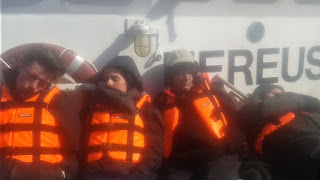Sampling (Sleeping) Beauties
Busy days at the Sven Lovén Centre! Our sampling days have started!
Zips are up, beanies are on! The cold wind in our faces is the perfect wake-up call, stronger than coffee. Doesn’t matter, sun is shining, and we are on a boat!
We started testing our methodology to find out which one works best for the assessment of the different marine communities of the Tjärnö Bay. We are using four methods, and our objective is to compare techniques based on a trawling and video on a sledge, and baited underwater video and photo-quadrats using an amazingly high-tech landing platform (see pictures).
Every day, our sailors go on the boat hunting for diversity. Meanwhile, our landrats wait on land for the samples to arrive, either in big boxes full of marine life or inside a little underwater camera. Everyone gathers around with excitement waiting to find out what was the catch of the day.
It’s amazing to see the amount of little organisms hidden beneath the cold water of the little bay. Videos and photos show the different communities and the different types of bottom working as an habitat for them. Trawling catches show the different communities hidden between lots and lots and lots of sea algae and ascidians. As much as this method is good at allowing us to find these hidden organisms, there is no doubt of its impact on the benthic communities and all the surrounding populations in the habitat. As so, some ethical issues start to arise in our conservationist minds. In fact, how controversial it can be assessing biodiversity by removing it? Everybody is excited for the data analysis and dreaming of discovering which method works best for the assessment of the diverse species in the Tjärnö Bay.
Days are fun, and data is being produced! Our active team is always awake, looking for species. Besides that, all the 5 minutes, when we are not counting how many sea stars we were able to see in our videos or weighing ascidians, are very useful to close our eyes and ‘reflect’ on the topic. Even our supervisor, Prof. Karim Erzini, is doing the same!
But, hey, that’s how you know you are working hard, no?
Zips are up, beanies are on! The cold wind in our faces is the perfect wake-up call, stronger than coffee. Doesn’t matter, sun is shining, and we are on a boat!
We started testing our methodology to find out which one works best for the assessment of the different marine communities of the Tjärnö Bay. We are using four methods, and our objective is to compare techniques based on a trawling and video on a sledge, and baited underwater video and photo-quadrats using an amazingly high-tech landing platform (see pictures).
Every day, our sailors go on the boat hunting for diversity. Meanwhile, our landrats wait on land for the samples to arrive, either in big boxes full of marine life or inside a little underwater camera. Everyone gathers around with excitement waiting to find out what was the catch of the day.
It’s amazing to see the amount of little organisms hidden beneath the cold water of the little bay. Videos and photos show the different communities and the different types of bottom working as an habitat for them. Trawling catches show the different communities hidden between lots and lots and lots of sea algae and ascidians. As much as this method is good at allowing us to find these hidden organisms, there is no doubt of its impact on the benthic communities and all the surrounding populations in the habitat. As so, some ethical issues start to arise in our conservationist minds. In fact, how controversial it can be assessing biodiversity by removing it? Everybody is excited for the data analysis and dreaming of discovering which method works best for the assessment of the diverse species in the Tjärnö Bay.
Days are fun, and data is being produced! Our active team is always awake, looking for species. Besides that, all the 5 minutes, when we are not counting how many sea stars we were able to see in our videos or weighing ascidians, are very useful to close our eyes and ‘reflect’ on the topic. Even our supervisor, Prof. Karim Erzini, is doing the same!
But, hey, that’s how you know you are working hard, no?







Comments
Post a Comment